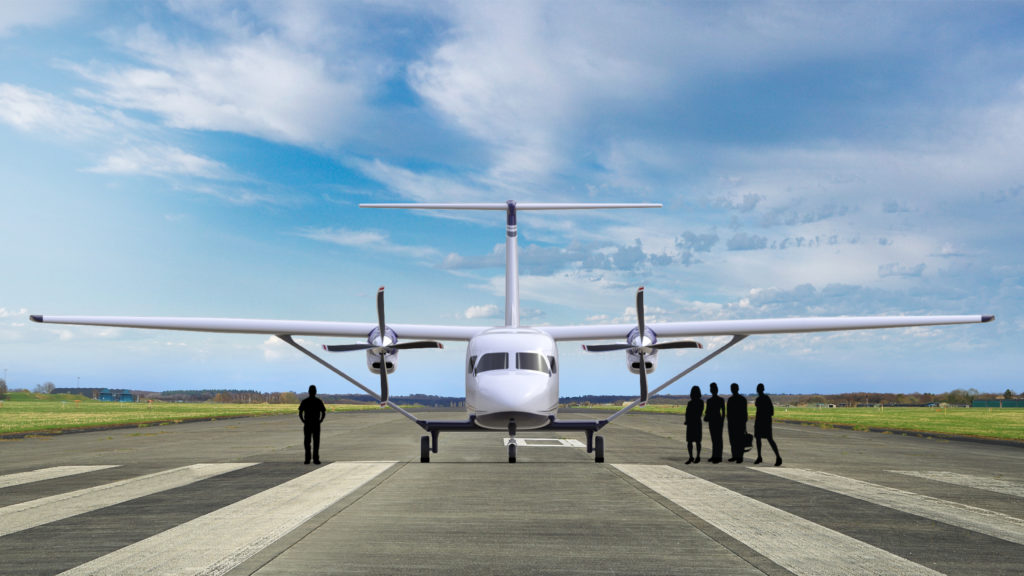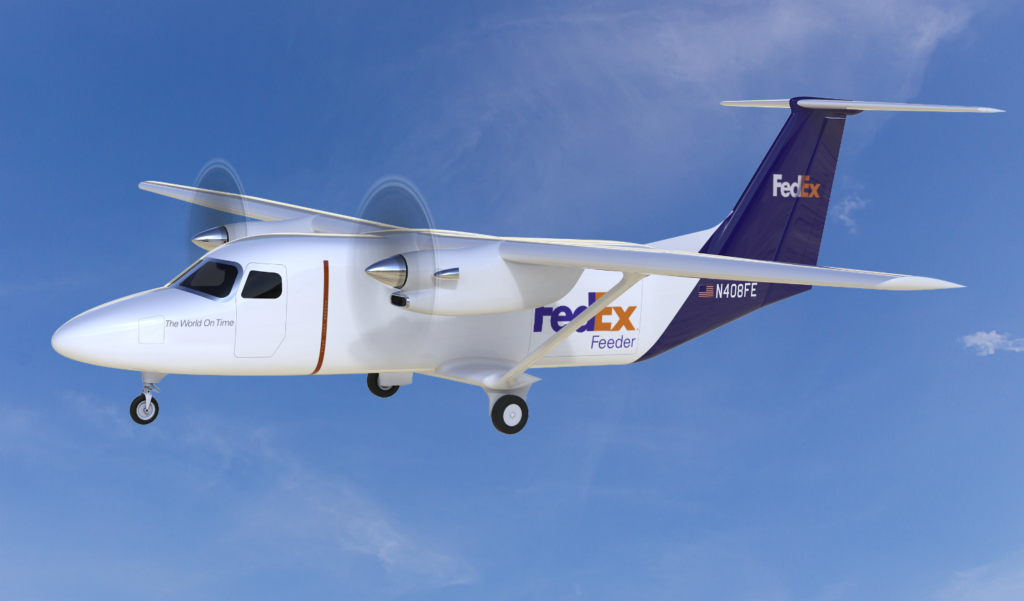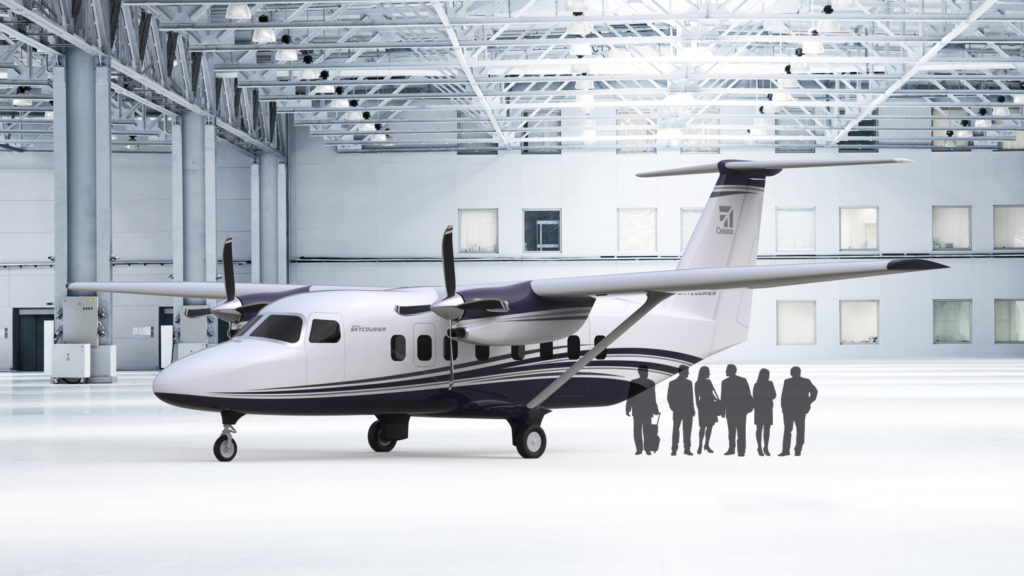Estimated reading time 7 minutes, 53 seconds.
Although Textron Aviation formally announced its plan to build the Cessna SkyCourier 408 on Nov. 28, 2017, the clean-sheet cargo workhorse has actually been under development for about seven months.

FedEx Express approached Textron in the spring about developing the large twin-engine utility aircraft, and the two collaborated on a design that would meet the operator’s mission requirements.
“We supply them with their current model 208 Caravan that they use extensively, so we had a history together,” said Brad Thress, Textron Aviation’s senior vice-president, Engineering. “That’s how it started.”
He told Skies that the SkyCourier was essentially designed to handle up to three FedEx Express LD3 cargo containers.
“That determined the dimensions of the rectangle we’d have to build the plane around. Once we had that space, we went about building an airplane around it.”
Thress said the next step was designing the plane’s cargo handling system.

“The cargo floor has built-in rollers so that when you put a pallet on the floor, you can easily roll it forward or aft. We put the cargo-handling floor in the design and added a large hinged door aft of the trailing edge of the wing. It’s hinged at the top; it raises out of the way so the plane can be loaded with a forklift.”
From there, Textron set about designing “the most simple, straightforward utility airplane that we could,” said Thress.
The SkyCourier has been designed to move freight quickly and effectively, but it purposely lacks many of the bells and whistles found on other modern aircraft. For instance, it eschews composites in favour of a traditional aluminum skin and propellers. Its cabin is unpressurized, its landing gear fixed, and the cockpit will feature a standard Garmin G1000 NXi avionics suite (including ADS-B In and Out capability) and manual flight controls.
“There won’t be any fancy hydraulic flight control systems or fly by wire,” noted Thress. “It will be a very simple airplane–and a non-complex airplane results in a much higher dispatch reliability rate.”
It may be simple, but the SkyCourier will be efficient. With a 6,000-pound maximum payload capability, the high-wing turboprop will cruise at up to 200 knots true airspeed (KTAS) with a range of 900 nautical miles.

It will be powered by a pair of 1,100-shp Pratt & Whitney Canada PT6A-65SC engines, enhanced with a fully connected engine monitoring system.
Engineered for high payloads, the new PT6A variant was optimized specifically for the SkyCourier 408, according to Nicholas Kanellias, vice-president, General Aviation at Pratt & Whitney Canada (P&WC).
“This engine will create a lot of power in a small package, and it will do it with a very good maintenance schedule and low cost of operation, and we’re going to do it all quickly and efficiently in what would seem like a very tight time frame,” he told Skies.
Kanellias said one of the benefits of the PT6 engine family is its adaptability.
“It’s been our bread and butter to optimize and in short order create an engine which our OEMs can use to power a new aircraft.”

The SkyCourier’s PT6A-65SC engines will benefit from P&WC’s integrated FAST (flight acquisition, storage and transmission) monitoring system and oil analysis technology, and will be supported by the manufacturer’s worldwide service network.
“This engine comes with all of that,” said Kanellias. “So it’s peace of mind for operators, especially one like FedEx, who counts on being able to manage their business in a very tight way.”
Aggressive timeline
Textron is targeting a 2020 entry into service date for the SkyCourier. FedEx Express expects to take delivery of the first aircraft by mid-year, with one aircraft delivered per month from then on, over a four-year period.
Thress agreed the program’s timeline is ambitious, but feels the integration of “proven technology” will help to expedite certification.
The exterior shape of the SkyCourier has now been defined, and wind tunnel models are currently being built for scheduled testing in January. Those results will define and confirm the plane’s aerodynamic performance and structural loads.
At the same time, Textron will work with FedEx Express and the U.S. Federal Aviation Administration (FAA) to design a maintenance program for the new airplane, system by system.
Thress said that once it’s approved by the FAA, the program will become a living document that will be reviewed and updated annually based on fleet inspection findings.
Passenger variant
Textron also announced that it will build an unpressurized 19-passenger version of the SkyCourier. Both the cargo and the passenger models will be certified for single-pilot operation.
“Some operators want to use it as a crew airplane so the co-pilot can log second-in-command time. We’re working on that,” said Thress.
He added that since plans for the aircraft were unveiled on Nov. 28, Textron has already received “four to six expressions of interest” from domestic operators who are interested in the passenger configuration of the SkyCourier.
“I think there’s a lot of potential. I think the market there is as big, or bigger, than the freight version,” continued Thress. “When we look at the global fleet of Caravans in passenger-carrying operations, it’s pretty extensive, especially in Africa and Asia.”
In terms of a timeline for Canadian certification, Textron pursues international validations based on sales. So if a Canadian customer orders the SkyCourier, Transport Canada certification will be prioritized.
Thress said the new aircraft would be a great fit for rural Canadian operators, with float certification expected in 2021.
The SkyCourier is the latest entry in an aircraft category that includes the Czech LET 410, the Polish Skytruck and China’s Harbin Y-12–and of course, Canada’s own Viking Air Series 400 Twin Otter.
Both the cargo and the passenger variants of the Cessna SkyCourier 408 will be sold through the factory in Wichita, Kan.









Many OEM’s have tried to invade the Twin Otter Market over the years and some OEM’s are still trying with their derelict fleets of Y12, D228, Let 410, CASA 212, N219 and AN2 Aircraft. If Textron seriously intends to compete with the Twin Otter Head to Head then Textron must think outside the traditional OEM box then build the C408 to the same or better performance standards than the Twin Otter in all configurations plus offer to the smaller global Part 135 customers 90% financing which Viking Air has been unable to do thus far forcing Viking to lay off 60% of their work force. OEM’s must have a minimum two year backlog for long term planning. Ground clearance is very crucial for the STOL unimproved runway operations. Textron will need to produce two models. One C408 I or PF model aka SkyCourier for FEDEX to launch the C408 program and then another model C408 II version to specifically compete directly with the Twin Otter with heavy duty high flotation landing gear utilizing the larger tires for unimproved STOL runways, snow skies for Antarctica and even standard floats for operations in the Maldives. I would like to see the revised takeoff performance distance reduced to 700 meters for the C408 II model to see if Textron really intends to compete with the Twin Otter or does Textron only intend to compete in the D228, N219, Y12 and Let 410-UVPE Aircraft market.
My Additional comments today:
Textron’s primary goal should be to sell sell sell. Once FEDEX takes delivery of the 50 to 100 SkyCourier Aircraft then what. Building a unpressurized 19 pax SkyCourier with giant PT6A-65 engines does not compete with the pressurized B1900. That leaves the derelict Y12E, D228-212, Let 410, AN2, Casa 212-200 and the new Indonesian N219 Aircraft that are still trying to compete with the Twin Otters. The SkyCourier has similar performance as the rest of these derelicts. If Textron wants to build another derelict Aircraft then continue with the current SkyCourier pax Aircraft plans. Textron would be lucky to sell 50 SkyCourier pax Aircraft over the next 20 years. If Textron wants to sell 500 plus C408 II Aircraft over the next 10 to 20 years then Textron must take off their gloves and design and build a C408 II that will be as good as or better than performance stats of a Twin Otter.
Many OEM’s have tried to invade the Twin Otter Market over the years and some OEM’s are still trying with their derelict fleets of Y12, D228, Let 410, CASA 212, N219 and AN2 Aircraft. If Textron seriously intends to compete with the Twin Otter Head to Head then Textron must think outside the traditional OEM box then build the C408 to the same or better performance standards than the Twin Otter in all configurations plus offer to the smaller global Part 135 customers 90% financing which Viking Air has been unable to do thus far forcing Viking to lay off 60% of their work force. OEM’s must have a minimum two year backlog for long term planning. Ground clearance is very crucial for the STOL unimproved runway operations. Textron will need to produce two models. One C408 I or PF model aka SkyCourier for FEDEX to launch the C408 program and then another model C408 II version to specifically compete directly with the Twin Otter with heavy duty high flotation landing gear utilizing the larger tires for unimproved STOL runways, snow skies for Antarctica and even standard floats for operations in the Maldives. I would like to see the revised takeoff performance distance reduced to 700 meters for the C408 II model to see if Textron really intends to compete with the Twin Otter or does Textron only intend to compete in the D228, N219, Y12 and Let 410-UVPE Aircraft market.
My Additional comments:
Textron’s primary goal should be to sell sell sell. Once FEDEX takes delivery of the 50 to 100 SkyCourier Aircraft then what. Building a unpressurized 19 pax SkyCourier with giant PT6A-65 engines does not compete with the pressurized B1900. That leaves the derelict Y12E, D228-212, Let 410, AN2, Casa 212-200 and the new Indonesian N219 Aircraft that are still trying to compete with the Twin Otters. The SkyCourier has similar performance as the rest of these derelicts. If Textron wants to build another derelict Aircraft then continue with the current SkyCourier pax Aircraft plans. Textron would be lucky to sell 50 SkyCourier pax Aircraft over the next 20 years. If Textron wants to sell 500 plus C408 II Aircraft over the next 10 to 20 years then Textron must take off their gloves and design and build a C408 II that will be as good as or better than performance stats of a Twin Otter.
The first pictures (before sizes comparison) are quite deceivable. That bird is kinda bit impressive in size.
The first 25 Viking Air DHC-6-400 Twin Otters were offered at $2.5 million USD. Within a few years prices escalated to $7.0 million USD green. The same will happen with the C408. Launch prices are much lower than actual market prices. The C408 II pax will end up around $8.0 million USD green. The -65 engines fuel burn will be higher. The 90% financing will be the key to selling the C408 II pax. Same as Raytheon did with the Beech 1900’s. The C408 II pax has the power so Textron needs to take it one step further and design the STOL version while they are in the development phase to match or surpass the Twin Otter performance stats in all utility configurations. This will guarantee the success of the C408 II for the next 50 years. There has never been a competitor to the Twin Otter. Will Textron be up to the challenge or ???